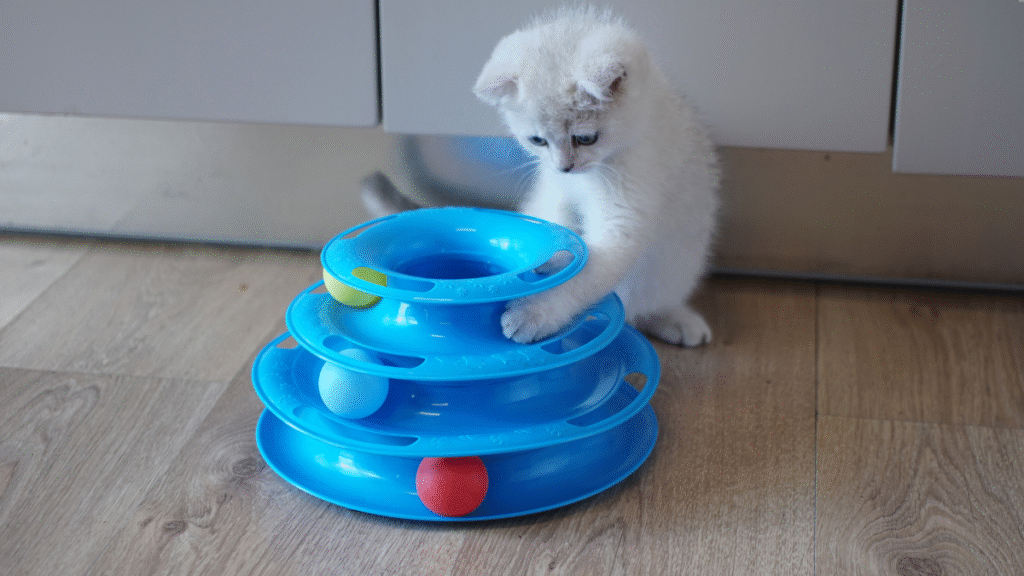Cats are naturally curious, playful, and intelligent animals that require mental and physical stimulation to stay happy and healthy. Without enough enrichment and exercise, cats can become bored, anxious, and may develop destructive behaviors such as scratching furniture, excessive meowing, or inappropriate toileting.
While there are many great cat toys available at pet stores, you don’t have to spend money to keep your feline friend entertained. With a bit of creativity and some household items, you can make simple, fun, and effective DIY cat enrichment toys at home.
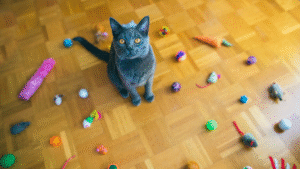
Why Cat Enrichment Is Important
Enrichment is the process of improving your cat’s environment and daily routine to encourage natural behaviors like hunting, chasing, scratching, playing, and exploring. Domestic cats are descendants of wild hunters and still possess strong instinctual drives that need healthy outlets.
Without enrichment activities, your cat can become frustrated, bored, and may experience stress or anxiety. Enrichment toys and games provide both mental and physical exercise that can:
-
Prevent boredom and stress
-
Encourage physical activity and healthy weight management
-
Strengthen the bond between you and your cat
-
Develop problem-solving skills
-
Reduce unwanted behaviors caused by frustration or lack of stimulation
DIY cat enrichment toys satisfy your cat’s natural urge to stalk, pounce, hunt, and play. They keep your cat mentally sharp and physically active while also giving you hours of entertainment watching them enjoy themselves.
Types of Cat Enrichment
Understanding the different types of cat enrichment can help you design a range of toys that target various instincts and behaviors.
-
Physical Enrichment: Toys that encourage movement, climbing, or chasing (e.g., balls, wands, tunnels).
-
Cognitive Enrichment: Puzzle feeders or toys that make your cat think and problem-solve for a reward.
-
Sensory Enrichment: Items that stimulate your cat’s senses—sight, smell, and touch.
-
Social Enrichment: Interactive playtime or social engagement with you or other pets.
-
Environmental Enrichment: Enhancing your home with scratching posts, hiding spots, and climbing perches.
DIY toys can combine more than one of these enrichment types, making them even more beneficial.

DIY Cat Enrichment Toys and Games
Now let’s explore some fun and easy DIY cat toys you can make with common household materials. Many of these not only entertain your cat but also promote exercise and help prevent boredom.
1. Toilet Paper Roll Puzzle Feeder
One of the easiest DIY cat toys to make is a puzzle feeder using empty toilet paper rolls. This interactive toy challenges your cat’s problem-solving skills and helps slow down fast eaters.
What you’ll need:
-
Several empty toilet paper rolls
-
A cardboard box (or shoebox)
-
Cat treats or dry kibble
Instructions:
-
Place several toilet paper rolls upright inside the box.
-
Drop a few treats or pieces of kibble into the rolls.
-
Allow your cat to figure out how to fish the treats out with their paw or nose.
You can increase the difficulty by taping the rolls together or partially covering some with paper.
2. Sock and Catnip Toy
Catnip is an irresistible treat for many cats and can make even the simplest toy exciting. This DIY catnip sock toy is easy, cheap, and fun to make.
What you’ll need:
-
A clean old sock
-
Dried catnip
-
Cotton or fabric scraps for stuffing
-
String or ribbon (optional)
Instructions:
-
Fill the sock with a handful of catnip and some soft stuffing.
-
Tie a knot at the open end, or use a string to close it securely.
-
Shake it to distribute the scent and drop it for your cat to play with.
Your cat will bat it, kick it, and cuddle it. Make a few extra and rotate them to keep playtime fresh and engaging.
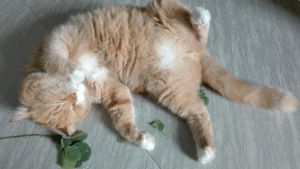
3. Cardboard Box Hide-and-Seek
Cats love cardboard boxes and will happily explore one for hours. You can easily turn a box into a hide-and-seek play zone.
What you’ll need:
-
A medium-sized cardboard box
-
Scissors or a box cutter
-
A few small cat toys or balls
Instructions:
-
Cut several holes of different sizes in the sides and top of the box.
-
Place toys or crumpled paper balls inside.
-
Let your cat peek, paw, and pounce through the holes.
For added fun, toss a few treats inside and lightly close the box so your cat has to figure out how to get them.
4. Feather Wand or String Chase Toy
Interactive play is essential for bonding and exercise. A homemade feather wand is simple to make and provides endless entertainment.
What you’ll need:
-
A wooden dowel or stick
-
String or ribbon
-
Feathers, fabric strips, or bells
Instructions:
-
Tie one end of the string to the stick.
-
Attach feathers or fabric strips to the other end.
-
Wave, drag, or dangle it for your cat to chase.
Always supervise your cat during playtime with string toys to prevent tangling or accidental swallowing.
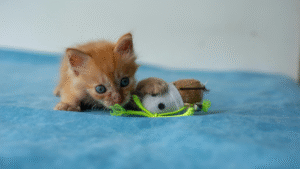
5. Tennis Ball Treat Dispenser
This fun DIY puzzle toy engages your cat’s brain and encourages movement during feeding.
What you’ll need:
-
A clean tennis ball
-
A sharp knife or scissors
-
Cat treats or kibble
Instructions:
-
Cut a small slit in the side of the tennis ball.
-
Fill it with treats or dry food.
-
Let your cat roll, paw, and chase it to release the food.
It’s a great way to make mealtime more interactive and encourage exercise, especially for indoor cats.
6. Bottle Cap Chase Toy
Looking for a super simple DIY cat toy? Bottle caps make excellent lightweight chase toys.
What you’ll need:
-
Plastic bottle caps (from water or soda bottles)
-
Optional: small bells or pebbles
Instructions:
-
Wash the caps thoroughly.
-
Drop a few on the floor and toss them for your cat to chase.
-
Add small items inside for a fun rattling sound.
Always supervise to ensure your cat doesn’t chew or swallow small pieces.
7. Paper Bag Adventure Tunnel
Sometimes the simplest things make the best toys. A paper bag offers sound, texture, and a perfect hiding place.
What you’ll need:
-
A large paper bag (without handles)
Instructions:
Open the bag and place it on the floor. Cats love to crawl inside, hide, and pounce. Sprinkle a little catnip or drop a toy inside to make it even more enticing.
For added fun, connect multiple bags to create a mini tunnel system.
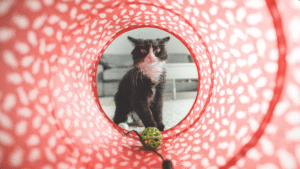
8. DIY Scratching Post
Scratching is a natural and essential behavior for cats. Instead of buying one, you can easily make your own scratching post.
What you’ll need:
-
A sturdy wooden base
-
A thick cardboard tube or wooden pole
-
Sisal rope or old carpet
-
Glue or a staple gun
Instructions:
-
Securely attach the pole to the base.
-
Wrap the pole tightly with sisal rope, gluing or stapling as you go.
-
Place the post in your cat’s favorite scratching area.
This DIY post not only protects your furniture but also provides your cat with a healthy outlet for stretching and claw maintenance.
9. Cat Treat Treasure Hunt
You don’t always need toys for enrichment—sometimes, your home can become the playground.
Instructions:
Hide small treats in safe spots around your home—under furniture edges, inside boxes, or on low shelves. Encourage your cat to use their nose and hunting instincts to find them.
This simple game satisfies your cat’s natural foraging behavior and provides great mental stimulation.
10. Crinkle Ball from Aluminum Foil
A crumpled ball of foil makes a fantastic toy that mimics the texture and sound of prey.
What you’ll need:
-
A small piece of aluminum foil
Instructions:
Crumple the foil into a small, firm ball and toss it for your cat to chase.
Make sure the ball is large enough that it can’t be swallowed, and replace it if it begins to break apart.

Tips for Successful DIY Cat Enrichment
-
Rotate toys regularly: Cats can get bored easily. Keep a few toys out and rotate them every few days.
-
Supervise play: Always watch your cat during play, especially with toys that include strings or small parts.
-
Incorporate scent: Add catnip, silvervine, or even a piece of your clothing to make toys more appealing.
-
Encourage movement: Use toys that make your cat chase, jump, and pounce.
-
Mix activities: Combine puzzle feeders for mealtime with active play toys for variety.
Final Thoughts
You don’t need to spend much to keep your cat mentally and physically stimulated. With a few simple materials found around the house, you can create engaging DIY cat enrichment toys that tap into your cat’s natural instincts and curiosity.
Whether it’s a cardboard maze, a homemade feather wand, or a treat puzzle, these activities can provide hours of fun and strengthen the bond between you and your feline friend.
- Homemade Calming Spray To Help Dogs During Training - November 12, 2025
- 7 DIY Dog Training Tools You Can Make From Household Items - November 12, 2025
- How To Make Your Own Clicker For Dog Training - November 12, 2025
